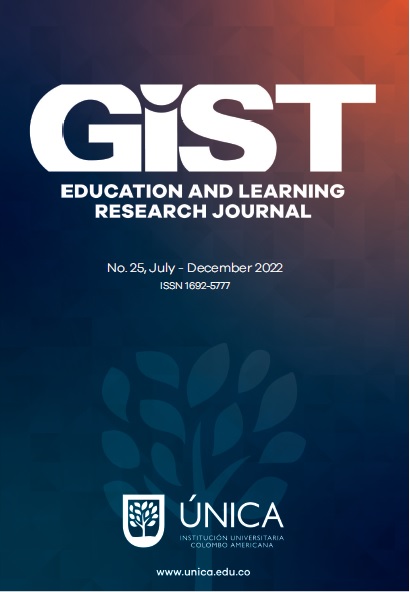Una Indagación Narrativa de no Ficción Creativa sobre una Comunidad Estudiantil en Línea Durante la Pandemia de COVID-19
DOI:
https://doi.org/10.26817/16925777.1534Palabras clave:
No Ficción Creativa, Indagación Narrativa, Archivo de Memoria, Coronavirus, E-me, EFLResumen
Muchas bibliotecas universitarias del mundo desarrollan archivos de la memoria del COVID-19 para la documentación de la experiencia personal. Recabar los datos mediante registros en diario y entrevistas de historia oral pertenece a la categoría de narrativa de vida. Dicha indagación narrativa se centra en relatos de no ficción creativa producidos por una comunidad estudiantil de secundaria en línea y editados por su profesora de inglés durante el primer confinamiento en Grecia. Por causa del cambio a la educación a distancia los estudiantes utilizaron la lengua inglesa para contribuir al archivo de memoria global. La profesora de inglés, como investigadora, utilizó textos modelo, recopiló los relatos en la plataforma en línea e-me, inició un proceso de revisión por pares y redactó una narrativa colectiva. Con el análisis narrativo se relaciona la iniciativa de la profesora para conmemorar la desconexión de una comunidad estudiantil de la educación presencial. El uso de e-me conlleva implicaciones prácticas para los profesionales de la enseñanza de la lengua inglesa, como la superación de los límites del currículo tradicional. Al mismo tiempo, la autorregulación se presenta como indicación de una cultura de resiliencia frente a circunstancias impredecibles.
Descargas
Referencias bibliográficas
Bakhtin, M. M. (1981). The dialogic imagination: Four essays by M. M. Bakhtin. University of Texas Press.
Barkhuizen G., & Wette R. (2008). Narrative frames for investigating the experiences of language teachers. System, 36, 372-387. https://doi.org/10.1016/j.system.2008.02.002
Barkhuizen, G., Benson, P., & Chik, A. (2014). Narrative Inquiry in Language Teaching and Learning Research. Routledge. https://doi.org/10.4324/9780203124994
Barone, T., & Eisner, E. (1997). Arts-based educational research. In R. M. Jaeger (Ed.), Complementary methods for research in education (2nd ed.), (pp. 75-116). American Educational Research Association.
Barratt Hacking, E., Blackmore, C., Bullock, K., Bunnell, T., Donnelly, M., & Martin S. (2016). The International Mindedness Journey: School Practices for developing and assessing International Mindedness across the IB Continuum. https://www.ibo.org/globalassets/publications/ib-research/continuum/international-mindedness-final-report-2017-en.pdf.
Bennett, M. J. (Ed.). (2015). The Sage Encyclopedia of Intercultural Competence. SAGE Publications, Inc. https://doi.org/10.4135/9781483346267
Buchanan, R. J. (2020). What COVID-19 is teaching me about writing. Writing Teacher Education in Extraordinary Times, 9(1), 1-5.
Burroway, J. (2003). Writing fiction: A guide to narrative craft (6th ed.). Longman.
Caulley, D. N. (2008). Making qualitative research reports less boring: The techniques of writing Creative Nonfiction. Qualitative Inquiry, 14(3), 424-449. https://doi.org/10.1177/1077800407311961
Clandinin, D. J., & Connelly, F. M. (2000). Narrative Inquiry: Experience and story in qualitative research. Jossey-Bass.
Connelly, F. M., & Clandinin, D. J. (2006). Narrative inquiry. In J. L. Green, G. Camilli, & P. Elmore (Eds.). Handbook of complementary methods in education research (3rd ed.), (pp. 477-487). Lawrence Erlbaum.
Creswell, J. W. (2015). Planning, Conducting, and EvaIuating Quantitative and QuaIitative Research (5th ed.). Pearson.
Doman, E. (2015). Intercultural Communication as revealed in Language Learning Histories. The Journal of Intercultural Communication, 38. http://www.immi.se/intercultural/nr38/doman.html.
Engle, J. (2020, 20 March). How is the coronavirus outbreak affecting your life? How are you staying connected and sane in a time of social distancing? The New York Times. https://www.nytimes.com/2020/03/20/learning/how-is-the-coronavirus-outbreak-affecting-your-life.html.
Gamlen, P. (2020, March 18). Social Distancing: What story could this image tell? The New York Times. https://www.nytimes.com/2020/03/18/learning/social-distancing.html.
Gerard, P. (2018). Creative Nonfiction: Researching and crafting stories of real life (2nd ed.). Waveland Press, Inc.
Gutkind, L. (2000). Why I chose the creative nonfiction way of life. Fourth Genre: Explorations in Nonfiction, 2(1), 200-206. https://doi.org/10.1353/fge.2000.0000
Josselson, R. (2004). The hermeneutics of faith and the hermeneutics of suspicion. Narrative Inquiry, 14(1), 1-28. https://doi.org/10.1075/ni.14.1.01jos
Kennette, L., & Chapman, M. (2021). Providing positive student feedback in an online environment. Academia Letters, 1-3. https://doi.org/10.20935/AL203
Kim, J. (2016). Understanding Narrative Inquiry: The crafting and analysis of stories as research. SAGE Publications, Inc. https://doi.org/10.4135/9781071802861
Land, A. (2021, January 21). Gone astray. Malmö University. https://student.mau.se/en/calendar/Students-reflect-on-Corona-in-writing-and-photography/#accordion-73726
Liu, Y., & Xu, Y. (2011). Inclusion or exclusion? A Narrative Inquiry of a language teacher's identity experience in the 'New Work Order' of Competing Pedagogies. Teaching and Teacher Education, 27(3), 589-597. https://doi.org/10.1016/j.tate.2010.10.013
Lott, B. (2000). Toward a definition of Creative Nonfiction. Fourth Genre: Explorations in Nonfiction, 2(1), 192-200. https://doi.org/10.1353/fge.2013.0450
Malmö University (Producer). (2020). Creative Writing I-HT20-EN212A-02303. https://utbildningsinfo.mau.se/kurs/en212a/start/20202-02303/kursplan/20202
Megalou, E., Koutoumanos, A., Tsilivigos, Y., & Kaklamanis, C. (2015). Introducing "e-me," the Hellenic digital educational platform for pupils and teachers. Proceedings of EDULEARN15: Education and New Learning Technologies 7th annual International Conference (pp. 1-10). Barcelona, Spain. https://www.researchgate.net/publication/280095364_Introducing_e-me_the_Hellenic_Digital_Educational_Platform_for_Pupils_and_Teachers.
O'Sullivan, H. (2010). Autonomy abroad: Metaphors of Mündigkeit in Language Learner Narrative. Language and Intercultural Communication, 10(2), 106-108. https://doi.org/10.1080/14708470903348515
Patwell, B. (2021). Reflecting on leading meaningful change through COVID. Academia Letters, 1-7. https://doi.org/10.20935/AL480
Polkinghorne, D. E. (1988). Narrative knowing and the human sciences. State University of New York Press.
Polkinghorne, D. E. (1995). Narrative configuration in qualitative analysis. Qualitative Studies in Education, 8(1), 5-23. https://doi.org/10.1080/0951839950080103
Robinson, J. A., & Hawpe, L. (1986). Narrative thinking as a heuristic process. In T. R. Sarbin (Ed.). Narrative Psychology: The storied nature of human conduct, (pp. 111-125). Praeger.
Sameshima, P. (2007). Seeing shadows in new light: A Procatalepsis on Narrative Inquiry as professional development. New Horizons in Education, 55, 10-21.
Schulten, K. (2019, September 4). Mentor texts. The New York Times. https://www.nytimes.com/2019/09/04/learning/mentor-text-reflecting-on-anexperience.html.
Silverberg, M. (2019). Relief: Observations on Creative Nonfiction as Pedagogy. LEARNing Landscapes, 2, 249-258. https://doi.org/10.36510/learnland.v12i1.991
Spence, D. P. (1986). Narrative smoothing and clinical wisdom. In T. R. Sarbin (ed.), Narrative Psychology: The storied nature of human conduct (pp. 211-232). Praeger.
Ypsilanti, A. (2020, May 2). A change in morning habits. University of Oxford. https://oclw.web.ox.ac.uk/article/a-change-in-morning-habits
Descargas
Publicado
Cómo citar
Número
Sección
Licencia
Derechos de autor 2022 GIST – Education and Learning Research Journal

Esta obra está bajo una licencia internacional Creative Commons Atribución-NoComercial-SinDerivadas 4.0.
| Estadísticas de artículo | |
|---|---|
| Vistas de resúmenes | |
| Vistas de PDF | |
| Descargas de PDF | |
| Vistas de HTML | |
| Otras vistas | |








